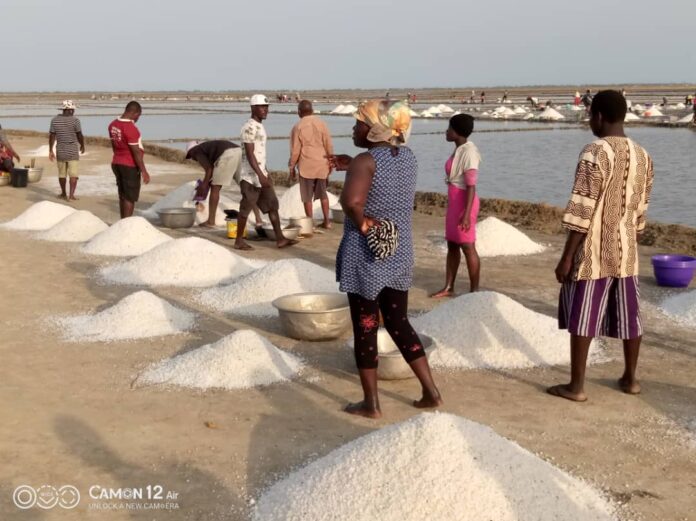
Salt miners in Anlo-Afiadenyigba along the Keta lagoon have complained over the lack of market for their product; a situation that has culminated into low pricing of their salt by buyers who travel long distances to purchase from them.
The miners told our reporter on Saturday that, due to unavailability of a ready market for the product, traders who come from areas like Ada and Sege to buy from them end up buying their product on extremely cheap prices.
A 50kg bag of salt costs just GHC 45.00 or less, while a 25kg bag costs GHC 15.00
According to Mr. Tamekloe (Charlie Pee), a leader of one of the five groups at the Afiadenyigba salt mines, the low pricing is a disincentive for themselves and the several women whose services they engage for the collection of the salt.
“We don’t have a market for what we collect here so people travel from Ada, Sege to buy from us and in the end, they determine the final price, which is usually so cheap.
This work is really tiresome and very difficult. Look at the conditions under which we are working but we can’t abandon it because this is our only source of livelihood, though the price is not encouraging we have no choice,” he noted.
Asked why they sell at such low prices, Charlie Pee said, “We can’t demand for higher prices because, the buyers would leave it and go away. But of course, the women we engage here too won’t allow that to happen; they want their share quickly so, sometimes they even sell the product to the buyers without the knowledge of the owners.”
In his opinion, the only way to stopping the low price problem is for government to create a market for their goods for export purposes and give them the power in determining the prices.
Workers here do not employ the use of any form of technology but rely solely on manpower for their production which lasts for a number of weeks.
Salt production around the Keta lagoon
There is a large production of salt at some parts of the Keta lagoon at specific times; becoming one of the major occupations for residents around the lagoon including Adina, Agbozume, Anlo-Afiadenyigba and Anyako.
During the harmattan season of November to February, stretching to March, the shallow parts of the lagoon get evaporated especially during years when rainfall is low. Salt crystal forms from the sodium chloride which is naturally available in the area.
Miners here make enclosures around the salty water to stop the flow of freshwater into it. The crystals grow large, which is collected mostly by women and sold to buyers who store it and sell when prices are high on the market.
Economists in Ghana believe that the nation’s salt industry represents a potential source of revenue from Nigeria traders who currently rely on imports from Brazil.
Source: Ghana | Starrfm.com.gh | Faisel Abdul-Iddrisu

